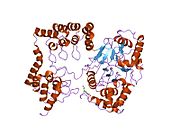Biology:PPP1CB
 Generic protein structure example |
Serine/threonine-protein phosphatase PP1-beta catalytic subunit is an enzyme that in humans is encoded by the PPP1CB gene.[1]
The protein encoded by this gene is one of the three catalytic subunits of protein phosphatase 1 (PP1). PP1 is a serine/threonine specific protein phosphatase known to be involved in the regulation of a variety of cellular processes, such as cell division, glycogen metabolism, muscle contractility, protein synthesis, and HIV-1 viral transcription. Mouse studies suggest that PP1 functions as a suppressor of learning and memory. Two alternatively spliced transcript variants encoding distinct isoforms have been observed.[2]
Interactions
PPP1CB has been shown to interact with PPP1R15A,[3][4] Nucleolin,[5] SMARCB1[3] and PPP1R9B.[6]
References
- ↑ "Three genes for protein phosphatase 1 map to different human chromosomes: sequence, expression and gene localisation of protein serine/threonine phosphatase 1 beta (PPP1CB)". Biochim Biophys Acta 1220 (2): 212–8. March 1994. doi:10.1016/0167-4889(94)90138-4. PMID 8312365.
- ↑ "Entrez Gene: PPP1CB protein phosphatase 1, catalytic subunit, beta isoform". https://www.ncbi.nlm.nih.gov/sites/entrez?Db=gene&Cmd=ShowDetailView&TermToSearch=5500.
- ↑ 3.0 3.1 Wu, Daniel Y; Tkachuck Douglas C; Roberson Rachel S; Schubach William H (August 2002). "The human SNF5/INI1 protein facilitates the function of the growth arrest and DNA damage-inducible protein (GADD34) and modulates GADD34-bound protein phosphatase-1 activity". J. Biol. Chem. 277 (31): 27706–15. doi:10.1074/jbc.M200955200. ISSN 0021-9258. PMID 12016208.
- ↑ Connor, J H; Weiser D C; Li S; Hallenbeck J M; Shenolikar S (October 2001). "Growth arrest and DNA damage-inducible protein GADD34 assembles a novel signaling complex containing protein phosphatase 1 and inhibitor 1". Mol. Cell. Biol. 21 (20): 6841–50. doi:10.1128/MCB.21.20.6841-6850.2001. ISSN 0270-7306. PMID 11564868.
- ↑ Morimoto, Hiroyuki; Okamura Hirohiko; Haneji Tatsuji (September 2002). "Interaction of protein phosphatase 1 delta with nucleolin in human osteoblastic cells". J. Histochem. Cytochem. 50 (9): 1187–93. doi:10.1177/002215540205000905. ISSN 0022-1554. PMID 12185196.
- ↑ Hsieh-Wilson, L C; Allen P B; Watanabe T; Nairn A C; Greengard P (April 1999). "Characterization of the neuronal targeting protein spinophilin and its interactions with protein phosphatase-1". Biochemistry 38 (14): 4365–73. doi:10.1021/bi982900m. ISSN 0006-2960. PMID 10194355.
Further reading
- "Molecular and linkage analysis of type-1 protein phosphatase catalytic beta-subunit gene: lack of evidence for its major role in insulin resistance in Pima Indians". Diabetologia 38 (4): 461–6. 1995. doi:10.1007/BF00410284. PMID 7796987.
- "Chromosomal localization of human, rat, and mouse protein phosphatase type 1 beta catalytic subunit genes (PPP1CB) by fluorescence in situ hybridization". Jpn. J. Genet. 69 (6): 697–700. 1995. doi:10.1266/jjg.69.697. PMID 7857673.
- "Normalization and subtraction: two approaches to facilitate gene discovery". Genome Res. 6 (9): 791–806. 1997. doi:10.1101/gr.6.9.791. PMID 8889548.
- "HOX11 interacts with protein phosphatases PP2A and PP1 and disrupts a G2/M cell-cycle checkpoint". Nature 385 (6615): 454–8. 1997. doi:10.1038/385454a0. PMID 9009195. Bibcode: 1997Natur.385..454K.
- "A new isoform of human myosin phosphatase targeting/regulatory subunit (MYPT2): cDNA cloning, tissue expression, and chromosomal mapping". Genomics 49 (1): 59–68. 1998. doi:10.1006/geno.1998.5222. PMID 9570949.
- "Characterization of the protein phosphatase 1 catalytic subunit in endothelium: involvement in contractile responses". J. Cell. Biochem. 79 (1): 113–25. 2000. doi:10.1002/1097-4644(2000)79:1<113::AID-JCB110>3.0.CO;2-9. PMID 10906760.
- "DNA cloning using in vitro site-specific recombination". Genome Res. 10 (11): 1788–95. 2001. doi:10.1101/gr.143000. PMID 11076863.
- "Toward a catalog of human genes and proteins: sequencing and analysis of 500 novel complete protein coding human cDNAs". Genome Res. 11 (3): 422–35. 2001. doi:10.1101/gr.GR1547R. PMID 11230166.
- "Phosphorylation of a novel myosin binding subunit of protein phosphatase 1 reveals a conserved mechanism in the regulation of actin cytoskeleton". J. Biol. Chem. 276 (24): 21209–16. 2001. doi:10.1074/jbc.M102615200. PMID 11399775.
- "Cell-cycle-dependent association of protein phosphatase 1 and focal adhesion kinase". Biochem. J. 358 (Pt 2): 407–14. 2001. doi:10.1042/0264-6021:3580407. PMID 11513739.
- "Directed proteomic analysis of the human nucleolus". Curr. Biol. 12 (1): 1–11. 2002. doi:10.1016/S0960-9822(01)00650-9. PMID 11790298.
- "A protein phosphatase from human T cells augments tat transactivation of the human immunodeficiency virus type 1 long-terminal repeat". Virology 296 (1): 6–16. 2002. doi:10.1006/viro.2002.1438. PMID 12036313.
- "Binding of the concave surface of the Sds22 superhelix to the alpha 4/alpha 5/alpha 6-triangle of protein phosphatase-1". J. Biol. Chem. 277 (49): 47331–7. 2003. doi:10.1074/jbc.M206838200. PMID 12226088.
- "Generation and initial analysis of more than 15,000 full-length human and mouse cDNA sequences". Proc. Natl. Acad. Sci. U.S.A. 99 (26): 16899–903. 2003. doi:10.1073/pnas.242603899. PMID 12477932. Bibcode: 2002PNAS...9916899M.
- "Exploring proteomes and analyzing protein processing by mass spectrometric identification of sorted N-terminal peptides". Nat. Biotechnol. 21 (5): 566–9. 2004. doi:10.1038/nbt810. PMID 12665801.
- "Differential transcriptional regulation by human immunodeficiency virus type 1 and gp120 in human astrocytes". J. Neurovirol. 9 (3): 358–71. 2003. doi:10.1080/13550280390201119. PMID 12775419.
- "Nuclear protein phosphatase-1 regulates HIV-1 transcription". J. Biol. Chem. 278 (34): 32189–94. 2003. doi:10.1074/jbc.M300521200. PMID 12788939.
- "SIPP1, a novel pre-mRNA splicing factor and interactor of protein phosphatase-1". Biochem. J. 378 (Pt 1): 229–38. 2004. doi:10.1042/BJ20030950. PMID 14640981.
- "A physical and functional map of the human TNF-alpha/NF-kappa B signal transduction pathway". Nat. Cell Biol. 6 (2): 97–105. 2004. doi:10.1038/ncb1086. PMID 14743216.



